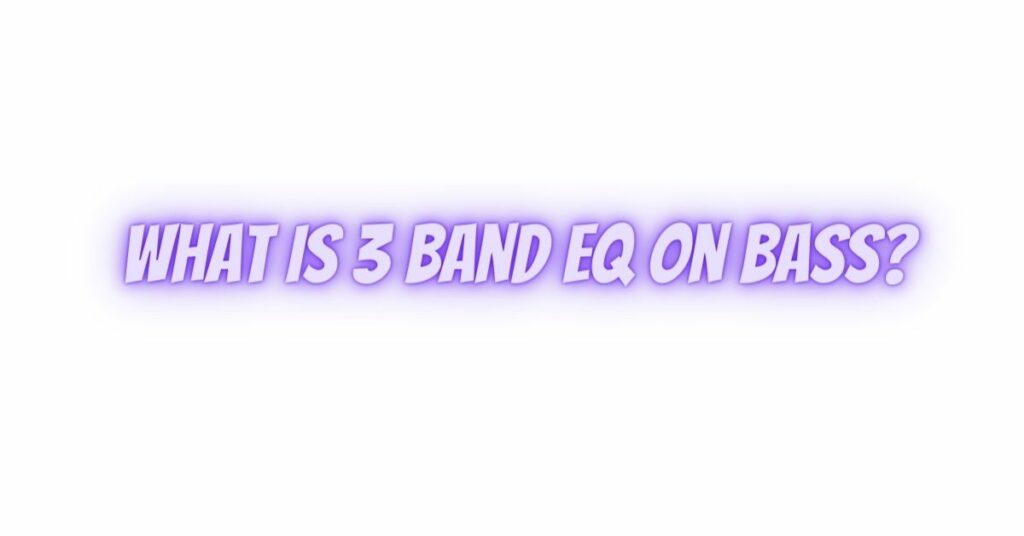The three-band equalizer (3-band EQ) is a fundamental tool in shaping the tonal characteristics of a bass guitar’s sound. Bassists, audio engineers, and producers rely on this essential feature to sculpt the low, mid, and high-frequency components of the bass signal. In this comprehensive article, we will explore the significance and operation of a 3-band EQ on a bass guitar, highlighting its role in creating a balanced and dynamic bass tone.
- The Basics of a 3-Band EQ
A 3-band EQ consists of three individual controls, each designed to affect a specific range of frequencies:
- Bass Control: The bass control typically targets low frequencies, allowing you to boost or cut the deep, foundational tones of your bass sound. Turning it up enhances the low-end thump and warmth, while reducing it creates a leaner, tighter sound.
- Midrange Control: The midrange control affects the mid-frequency range of your bass tone. It allows you to emphasize or attenuate the punch and presence in your sound. Boosting the midrange adds definition and can help your bass cut through a mix, while cutting it produces a smoother, less prominent tone.
- Treble Control: The treble control influences the high-frequency components of your bass sound. Adjusting it allows you to add brightness and clarity or soften the tone. Boosting treble can make your bass sound more articulate, while reducing it produces a smoother, warmer sound.
- Balancing the Frequencies
The primary purpose of a 3-band EQ is to balance the frequencies to achieve the desired tonal characteristics. Here’s how you can use it effectively:
- Enhancing Low-End Power: Boost the bass control to add warmth and depth to your bass tone. This is particularly useful for genres where a strong, low-end presence is essential, such as funk or reggae.
- Emphasizing Midrange Punch: Boosting the midrange control can make your bass sound punchier and more defined. It’s often used in rock and metal music to give the bass a more aggressive character.
- Adding Clarity and Articulation: Boosting the treble control can enhance the clarity and articulation of your bass playing. This is useful for genres like jazz or fusion where precision and detail are important.
- Finding Your Signature Sound
Every bassist has a unique playing style and musical preference, and the 3-band EQ allows you to tailor your sound to match your individuality. Experimentation is key to finding your signature sound. Here are some tips:
- Start at Flat: Begin with all EQ controls set at their midpoint (usually labeled as “0” or “12 o’clock”). This provides a neutral starting point.
- Listen Carefully: Play your bass and adjust each EQ control while listening attentively. Take note of how each adjustment affects your tone.
- Context Matters: Consider the musical context. Different genres and playing situations may call for different EQ settings.
- Subtle Changes: Small adjustments can often have a big impact. You don’t need to make extreme changes to achieve the desired sound.
- Record and Experiment: If possible, record your playing with different EQ settings and listen back to identify the one that best suits your style and the music you’re playing.
- Live Sound and Studio Applications
A 3-band EQ is an indispensable tool for both live sound and studio applications:
- In live sound, bassists use the EQ to adapt to different venues and ensure their bass cuts through the mix.
- In the studio, engineers and producers rely on the 3-band EQ to shape the bass sound and make it sit well in the mix, while also tailoring it to the genre and style of the music.
Conclusion
The 3-band EQ on a bass guitar is a versatile and powerful tool for bassists and sound engineers. It allows for fine-tuning the low, mid, and high frequencies to create a balanced and dynamic bass tone. With a solid understanding of how each control affects your sound, along with experimentation and careful listening, you can craft a unique and expressive bass tone that complements your playing style and musical preferences.


